One of the most profound changes affecting the Australian economy and society this century has been the massive lift in Australia’s net overseas migration (NOM) and population growth under the multi-partisan Big Australia policy.
This rapid population growth is projected to continue for decades to come, if current policy settings favouring high immigration continue.
The ABS medium (Panel B) population projections, released in 2018, have NOM continuing at current strong levels (225,000 people a year) for the next half century, in turn driving all of Australia’s projected 17.5 million population increase to 42.6 million people by 2066 (see Chart 2).
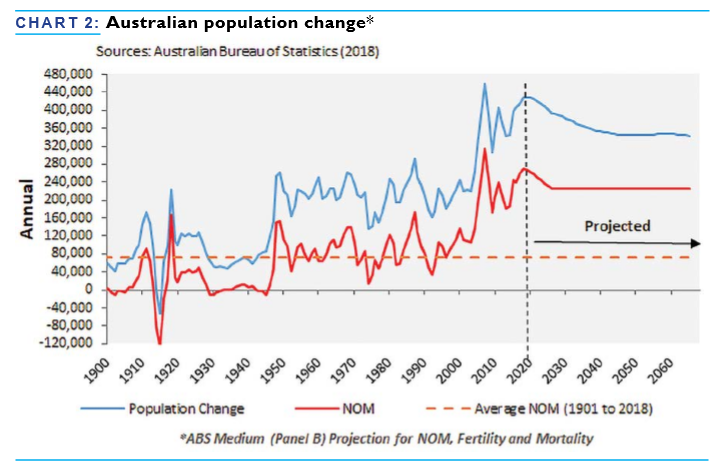
By 2066, Sydney’s (9.7 million) and Melbourne’s (10.2 million) populations are projected by the ABS to each be significantly larger than Australia’s entire population in 1950 (8.3 million) and only slightly below Australia’s population in 1960 (10.4 million) (see Chart 7).
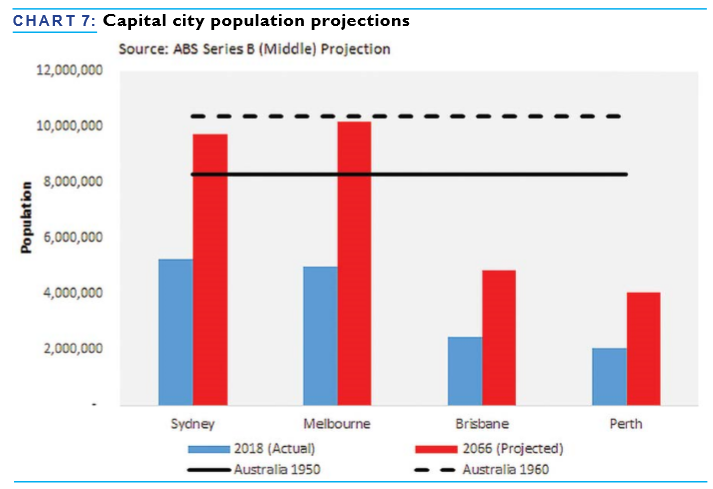
In addition to driving up congestion and eroding amenity, Australia’s mass immigration policy is transforming the structure of Australia’s cities from lower density detached housing toward high density. This change is most pervasive in Sydney and Melbourne where both immigration and population growth have been, and are projected to remain, the strongest.
In the eight years to December 2018, there were 115,000 detached houses approved for construction in Sydney, versus 232,000 units and apartments. Over the same period in Melbourne, there were 189,000 houses approved for construction versus 214,000 units and apartments.
With geographical and/or planning constraints limiting both cities’ ability to expand outwards, densification will intensify as a consequence of population ballooning. Projections from Urban Taskforce, a body representing large developers in Australia, illustrate the transformation taking place (see Chart 10).
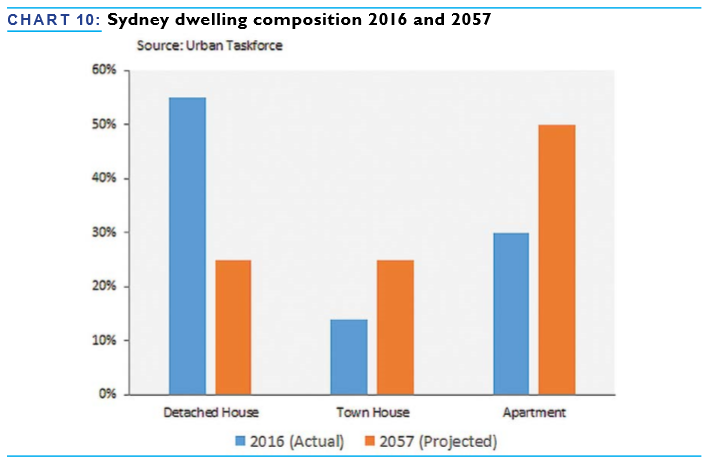
These projections show that, assuming Sydney reaches 10 million people shortly after mid-century, the share of Sydney’s dwelling stock comprised of detached housing will more than halve from 55 per cent in 2016 to 25 per cent in 2057. By contrast, apartments will increase their share of Sydney’s dwelling stock from 30 per cent to 50 per cent over the same period, whereas townhouses will increase their share from 14 per cent to 25 per cent.
The rapid population growth and densification of Australia’s two major cities has also helped drive the cost of housing to extreme levels.
In the 14 years to 2018, Sydney and Melbourne added 1,050,000 and 1,300,000 people respectively, of which 470,000 and 590,000 people were added in the five years to 2018 alone (see Chart 11).
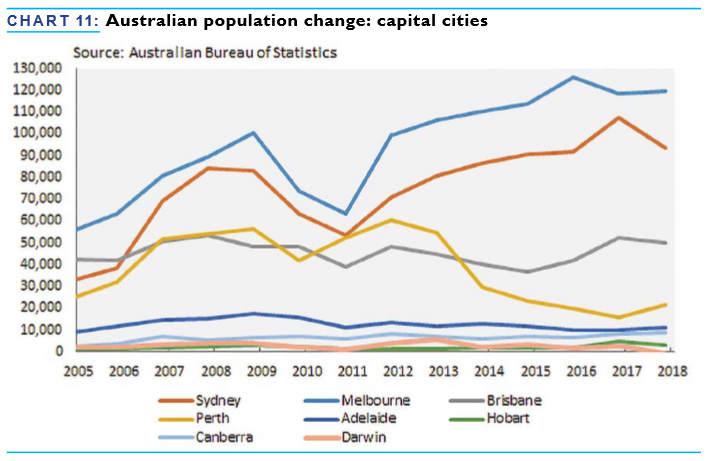
Reflecting this strong population growth, especially over the most recent five years, both Sydney’s and Melbourne’s dwelling price-to-income ratio surged to an extreme 9.1 and 7.5 respectively as at the end of 2017 – well beyond Australia’s other capital cities where population growth was lower (see Chart 12).
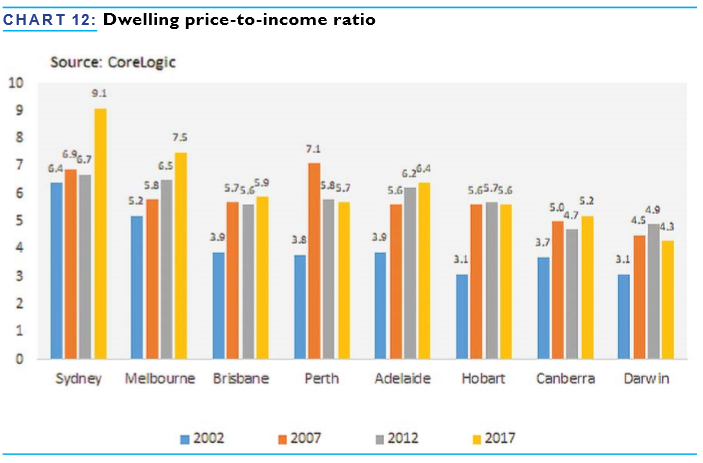
As a consequence, home ownership rates in both Sydney and Melbourne have collapsed among under-40 Australians (see Chart 13).
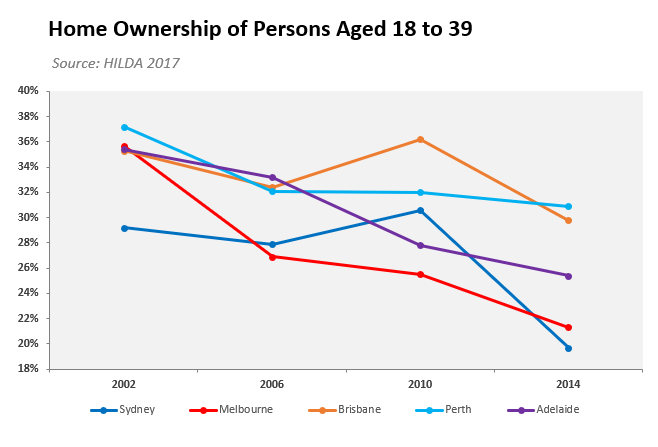
If, as per ABS standard projections, Sydney’s and Melbourne’s populations each balloon to around 10 million people over the next half century, driven by ongoing mass immigration, then the chronic housing affordability problems in both cities will continue.
In turn, both Sydney and Melbourne are facing a future where only the wealthiest residents will be able to afford a detached house with a backyard, while the majority of residents will be forced to live in cramped accommodation, an increasing share of whom will also be renting and with little or no access to green space.
This has direct implications for the economy. Australia’s retirement system is based around retirees owning their homes. The rapidly decreasing home ownership rate will ultimately leave many future pensioners starved of funds and reliant on the Federal Government for housing assistance.
It is now coming to light that the design and build quality of at least some of the mushrooming high-rise in our cities is under serious question. Not only are more people being shoe-horned into high-rise, but they face the risk and anxiety of shoddy construction that is very hard, if not impossible, to rectify. The willingness of state and local governments to relinquish decision-making to private companies via the use of ‘light touch’ regulatory and planning regimes is increasingly being questioned.
The often expressed hope that ‘better planning’ will be sufficient to overcome any challenges caused by population growth, fails to grasp that this growth is premised upon a compliant and malleable planning apparatus which enables developers to achieve maximum throughput, at lowest cost and for maximum reward. To do the planning ‘better’ would by definition be costlier and more time-consuming – and thus could not support the current high rates of population increase.
The above article is an edited extract of the new discussion paper, entitled “Population growth and Infrastructure in Australia: the catch-up illusion”, of which I was the lead author. This paper was commissioned by Sustainable Population Australia (SPA), which “is an Australian, non-partisan, special advocacy group that seeks to establish an ecologically sustainable human population”.

